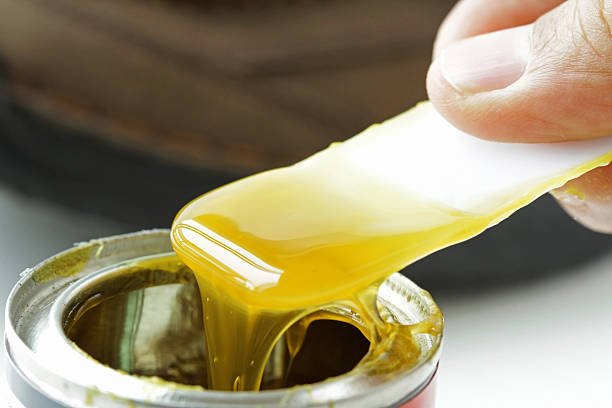Leder ist ein wunderbares Material, das für eine Vielzahl von Anwendungen verwendet wird. Egal ob es sich um Kleidungsstücke, Taschen, Möbel oder Schuhe handelt, Leder hat eine hohe Qualität und Langlebigkeit, die es zu einem beliebten Material für viele Menschen macht. Bei der Verarbeitung von Leder ist es oft notwendig, verschiedene Klebstoffe zu verwenden, um die einzelnen Teile zusammenzufügen und eine starke Verbindung zu gewährleisten. In diesem Blogeintrag werden die verschiedenen Klebstoffe, die in der Lederbearbeitung verwendet werden, genauer betrachtet.
- Naturkautschukkleber
Naturkautschukkleber ist ein Klebstoff, der aus Naturkautschuk gewonnen wird. Dieser Klebstoff wird oft in der Schuhherstellung verwendet und hat eine hohe Festigkeit und Elastizität. Er ist ideal für die Verbindung von Leder und Gummisohlen geeignet und sorgt für eine dauerhafte Verbindung.
- Polyurethankleber
Polyurethankleber ist ein synthetischer Klebstoff, der eine hohe Festigkeit und Wasserbeständigkeit aufweist. Er wird oft für die Verarbeitung von Leder verwendet, da er eine gute Haftung auf vielen verschiedenen Oberflächen aufweist. Er wird oft für die Verbindung von Leder auf Metall, Kunststoff oder Holz verwendet.
- Acrylkleber
Acrylkleber ist ein Klebstoff auf Wasserbasis, der oft für die Verarbeitung von Leder verwendet wird. Er hat eine hohe Festigkeit und Elastizität, und seine Transparenz macht ihn ideal für den Einsatz in der Lederbearbeitung. Er wird oft für die Verbindung von Leder auf Leder oder für die Verarbeitung von Lederteilen verwendet, die später sichtbar sein sollen.
- Epoxykleber
Epoxykleber ist ein Zweikomponenten-Klebstoff, der für die Verbindung von schweren Materialien verwendet wird. Er hat eine hohe Festigkeit und Härte, die ihn ideal für die Verarbeitung von Leder macht, die einer hohen Belastung ausgesetzt ist. Er wird oft für die Verbindung von Leder auf Metall oder für die Verarbeitung von schweren Lederstücken verwendet.
- Kontaktklebstoff
Kontaktklebstoff ist ein Klebstoff, der auf beiden Seiten aufgetragen wird, bevor die beiden Teile zusammengefügt werden. Er hat eine hohe Haftung und ist ideal für die Verbindung von Leder auf Leder oder für die Verarbeitung von Lederteilen, die später nicht sichtbar sein sollen. Kontaktklebstoff ist jedoch nicht wasserbeständig und sollte daher nicht für Anwendungen verwendet werden, die Wasser ausgesetzt sind.
Zusammenfassend lässt sich sagen, dass die Wahl des richtigen Klebstoffs für die Lederbearbeitung von der Art des Projekts und den Anforderungen abhängt. Jeder Klebstoff hat seine eigenen Vorteile und Einschränkungen, und es ist wichtig, den richtigen Klebstoff für das jeweilige Projekt auszuwählen, um eine dauerhafte Verbindung zu gewährleisten. Mit diesem Wissen können Sie sicherstellen, dass Ihre Lederprojekte robust und langlebig.
Gruß euer Frank von Leder oder so

Leather is a wonderful material that is used for a variety of applications. Whether it's garments, bags, furniture, or shoes, leather has a high quality and durability that makes it a popular material for many people. When processing leather, it is often necessary to use different adhesives to join the individual parts together and ensure a strong connection. In this blog post, we'll take a closer look at the different adhesives used in leather processing.
- Natural rubber glue
Natural rubber glue is an adhesive obtained from natural rubber. This adhesive is often used in shoe manufacturing and has high strength and elasticity. It is ideal for connecting leather and rubber soles and ensures a permanent connection.
- Polyurethane glue
Polyurethane glue is a synthetic adhesive that has high strength and water resistance. It is often used for the processing of leather, as it has good adhesion to many different surfaces. It is often used for the connection of leather to metal, plastic or wood.
Acrylic glue
Acrylic glue is a water-based adhesive that is often used for processing leather. It has high strength and elasticity, and its transparency makes it ideal for use in leather processing. It is often used for the connection of leather to leather or for the processing of leather parts that should be visible later.Epoxy glue
Epoxy glue is a two-component adhesive used for bonding heavy materials. It has a high strength and hardness, which makes it ideal for processing leather that is subjected to high loads. It is often used for the connection of leather to metal or for the processing of heavy pieces of leather.
- Contact adhesive
Contact adhesive is an adhesive that is applied on both sides before the two parts are joined together. It has a high adhesion and is ideal for joining leather to leather or for processing leather parts that should not be visible later. However, contact adhesive is not water resistant and therefore should not be used for applications that are exposed to water.
In conclusion, choosing the right adhesive for leather processing depends on the type of project and requirements. Each adhesive has its own advantages and limitations, and it is important to choose the right adhesive for the specific project to ensure a permanent bond. With this knowledge, you can ensure that your leather projects are sturdy and durable
Congratulations @lederoderso! You have completed the following achievement on the Hive blockchain And have been rewarded with New badge(s)
Your next target is to reach 200 upvotes.
Your next target is to reach 100 upvotes.
You can view your badges on your board and compare yourself to others in the Ranking
If you no longer want to receive notifications, reply to this comment with the word
STOPTo support your work, I also upvoted your post!
Check out our last posts:
Support the HiveBuzz project. Vote for our proposal!